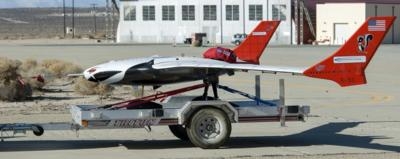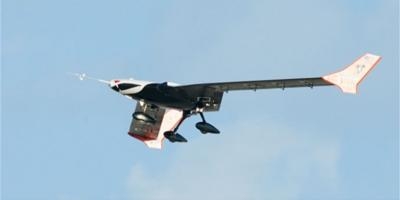Thu, Apr 17, 2014
Test Flights With A Flexible Wing To Be Conducted This Summer
The latest in a long series of experimental research aircraft, or X-planes, recently arrived at NASA's Armstrong Flight Research Center. Lockheed Martin, developer of the X-56A Multi-Utility Technology Testbed, is currently using the aircraft to explore technologies for active flutter suppression and gust load alleviation for the Air Force Research Laboratory's Multi-utility Aeroelastic Demonstration program.

The remotely piloted airplane had been housed at Edwards Air Force Base's North Base complex since last spring, where it was flown in a series of baseline tests involving a standard stiff wing. Pending resolution of scheduling and technical issues, the modular X-56A will be flown this summer with a flexible wing. Once these tests are concluded, the airplane and its ground control station will be transferred to NASA for follow-on research involving enabling technologies for new kinds of lightweight, energy-efficient, flexible aircraft.
According to NASA, the modular X-56A system includes two center bodies, a set of stiff wings, three sets of flexible wings, a ground control station, and a transportation trailer. The X-56A has easily removed wings and is convertible to other wing configurations, such as a joined-wing planform or a wing-tail configuration. The aircraft is equipped with a ballistic parachute recovery system, which is intended to recover the fuselage and the majority of the aircraft systems in the event of an inflight wing failure.

The initial flight tests of the X-56A system, performed by Lockheed and AFRL in the latter half of 2013 and extending into early 2014, collected flight data on highly flexible structures and flutter suppression control technology. Initially flown with a conventional stiff wing, the aircraft is subsequently being used to evaluate active flutter suppression with the flexible wings in early 2014. After these flights are completed, the X-56A will be transferred to NASA Armstrong to be used for research into lightweight structures and advanced control technologies for future efficient, environmentally friendly transport aircraft.
(Images provided by NASA)
More News
Airport Marking Aids Markings used on runway and taxiway surfaces to identify a specific runway, a runway threshold, a centerline, a hold line, etc. A runway should be marked in ac>[...]
"It is extremely difficult, if not impossible, for manned aircraft to see a drone while conducting crop-enhancing and other aerial applications at low altitudes and high speeds. We>[...]
Aero Linx: The Skyhawk Association The Skyhawk Association is a non-profit organization founded by former Skyhawk Pilots which is open to anyone with an affinity for the A-4 Skyhaw>[...]
“The T-54A benefits from an active Beechcraft King Air assembly line in Wichita, Kansas, where all required METS avionics and interior modifications are installed on the line>[...]
Aero Linx: Aerostar Owners Association The Association offers the Aerostar Owner a unique opportunity to tap an invaluable source of information concerning the care and feeding of >[...]
 ANN's Daily Aero-Term (04.28.24): Airport Marking Aids
ANN's Daily Aero-Term (04.28.24): Airport Marking Aids Aero-News: Quote of the Day (04.28.24)
Aero-News: Quote of the Day (04.28.24) ANN's Daily Aero-Linx (04.28.24)
ANN's Daily Aero-Linx (04.28.24) Aero-News: Quote of the Day (04.29.24)
Aero-News: Quote of the Day (04.29.24) ANN's Daily Aero-Linx (04.29.24)
ANN's Daily Aero-Linx (04.29.24)




